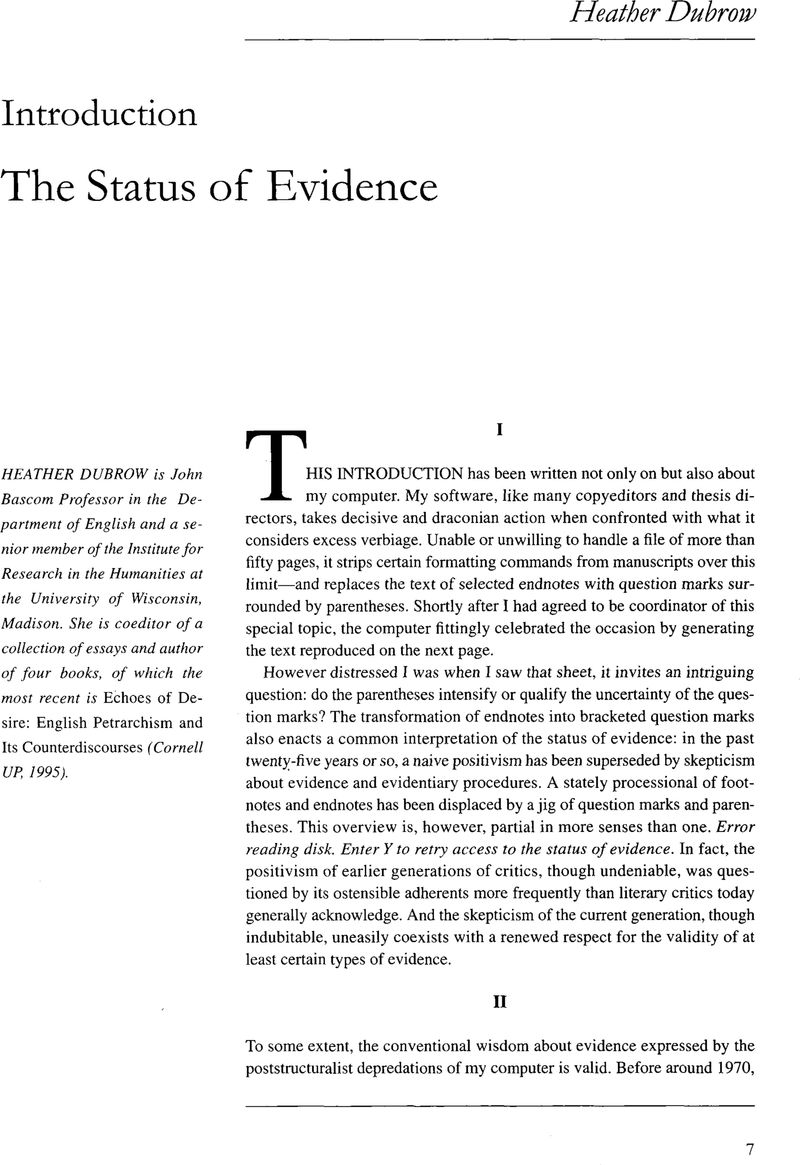No CrossRef data available.
Article contents
Introduction: The Status of Evidence
Published online by Cambridge University Press: 23 October 2020
Abstract
An abstract is not available for this content so a preview has been provided. Please use the Get access link above for information on how to access this content.

- Type
- Introduction
- Information
- Copyright
- Copyright © Modern Language Association of America, 1996
References
Works Cited
Adelman, Janet. Suffocating Mothers: Fantasies of Maternal Origin in Shakespeare's Plays, Hamlet to The Tempest. New York: Routledge, 1992.Google Scholar
Appleby, Joyce, Hunt, Lynn, and Jacob, Margaret. Telling the Truth about History. New York: Norton, 1994.Google Scholar
Asad, Talal, ed Anthropology and the Colonial Encounter. London: Ithaca; Atlantic Highlands: Humanities, 1975.Google Scholar
Beattie, J. M “The Pattern of Crime in England, 1660-1800.” Past and Present 62 (1974): 47–95.CrossRefGoogle Scholar
Bradley, A. C. Shakespearean Tragedy: Lectures on Hamlet, Othello, King Lear, Macbeth. 2nd ed. London: Macmillan, 1905.Google Scholar
Chandler, James, Davidson, Arnold I., and Harootunian, Harry, eds Questions of Evidence: Proof, Practice, and Persuasion across the Disciplines. Chicago: U of Chicago P, 1994.Google Scholar
Cockburn, J. S “The Nature and Incidence of Crime in England, 1559-1625: A Preliminary Survey.” Crime in England, 1550-1800. Ed. Cockburn. Princeton: Princeton UP, 1977. 49–71.Google Scholar
Curtis, Timothy, and Sharpe, J. A. “Crime in Tudor and Stuart England.” History Today [Great Britain] 38 (1988): 23–29.Google Scholar
Dasenbrock, Reed Way “We've Done It to Ourselves: The Critique of Truth and the Attack on Theory.” PC Wars: Politics and Theory in the Academy. Ed. Williams, Jeffrey. New York: Routledge, 1995. 172–17.Google Scholar
Dubrow, Heather. Echoes of Desire: English Petrarchism and Its Counterdiscourses. Ithaca: Cornell UP, 1995.CrossRefGoogle Scholar
Dubrow, Heather, and Strier, Richard Introduction. The Historical Renaissance: New Essays on Tudor and Stuart Literature and Culture. Ed. Dubrow and Strier. Chicago: U of Chicago P, 1988. 1–12.Google Scholar
Evans-Pritchard, E. E “Sanza, a Characteristic Feature of Zande Language and Thought.” Essays in Social Anthropology. London: Faber, 1962. 204–20.Google Scholar
Fabian, Johannes. Time and the Other: How Anthropology Makes Its Object. New York: Columbia UP, 1983.Google Scholar
Garber, Marjorie “Jell-O.” Secret Agents: The Rosenberg Case, McCarthyism, and Fifties America. Ed. Garber and Walkowicz, Rebecca L. New York: Routledge, 1995. 11–22.Google Scholar
Ginzburg, Carlo. The Cheese and the Worms: The Cosmos of a Sixteenth-Century Miller. 1976. Trans. John Tedeschi and Anne Tedeschi. Harmondsworth: Penguin, 1982.Google Scholar
Graff, Gerald. Professing Literature: An Institutional History. Chicago: U of Chicago P, 1987.Google Scholar
Graff, Gerald “The Pseudo-politics of Interpretation.” Critical Inquiry 9 (1983): 597–610.CrossRefGoogle Scholar
Kingdon, Robert M. Adultery and Divorce in Calvin's Geneva. Cambridge: Harvard UP, 1995.Google Scholar
Knights, L. C “How Many Children Had Lady Macbeth?” “Hamlet” and Other Shakespearean Essays. Cambridge: Cambridge UP, 1979. 270–308.Google Scholar
Mebane, John “Pluralism, Relativism, and the Question of Evidence: The Instance of Shakespearean Studies.” College English, forthcoming.Google Scholar
Novick, Peter. That Noble Dream: The “Objectivity Question” and the American Historical Profession. Cambridge: Cambridge UP, 1988.CrossRefGoogle Scholar
Nuttall, A. D. A New Mimesis: Shakespeare and the Representation of Reality. London: Methuen, 1983.Google Scholar
Richards, I. A. Practical Criticism: A Study of Literary Judgment. 2nd ed. New York: Harcourt; London: Kegan, 1930.Google Scholar
Rorty, Richard. Contingency, Irony, and Solidarity. Cambridge: Cambridge UP, 1989.CrossRefGoogle Scholar
Ross, David A. Foreword Evidence 1944-1994. Ed. Shanahan, Mary. New York: Random, 1994. 9.Google Scholar
Samaha, Joel. Law and Order in Historical Perspective: The Case of Elizabethan Essex. New York: Academic, 1974.Google Scholar
Scott, Joan W “The Evidence of Experience.” Chandler, Davidson, and Harootunian 363–36.Google Scholar
Sedgwick, Eve Kosofsky “Against Epistemology.” Chandler, Davidson, and Harootunian 132–13.Google Scholar
Shakespeare, William. The Riverside Shakespeare. Ed. Evans, G. Blakemore. Boston: Houghton, 1974.Google Scholar
Shapin, Steven. A Social History of Truth: Civility and Science in Seventeenth-Century England. Chicago: U of Chicago P, 1994.Google Scholar
Sharpe, J. A “Enforcing the Law in the Seventeenth-Century English Village. Crime and the Law: The Social History of Crime in Western Europe since 1500. Ed. Gatrell, V. A. C., Lenman, Bruce, and Parker, Geoffrey. London: Europa, 1980. 97–119.Google Scholar
Smith, Barbara Herrnstein. Contingencies of Value: Alternative Perspectives for Critical Theory. Cambridge: Harvard UP, 1988.Google Scholar
Stewart, Stanley “A Critique of Pure ‘Situating.‘” New Literary History 25 (1994): 1–19.CrossRefGoogle Scholar
Vickers, Brian. Appropriating Shakespeare: Contemporary Critical Quarrels. New Haven: Yale UP, 1993.Google Scholar




